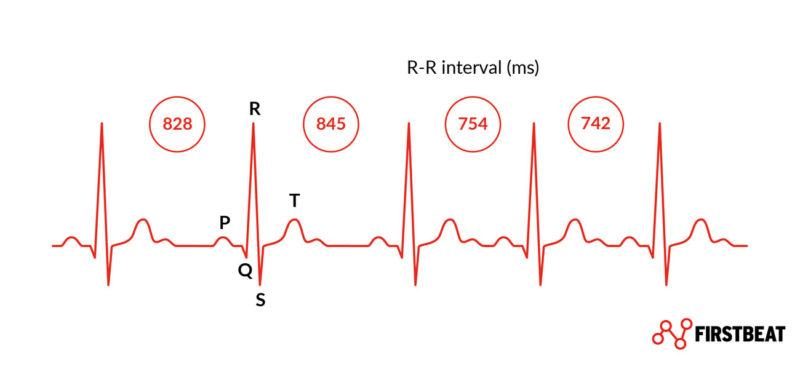
Translated from Satu Tuominen’s original blog in Finnish.
Would you like to recover better to improve your resilience and be able to meet life’s demands and challenges in a more flexible way? Would you like to learn how to structure and plan your workouts more effectively to boost performance gains. Or is your goal to coach your clients in a more comprehensive manner, considering individual differences in the ability to recover and handle stress?
Measuring heart rate variability (HRV) is a key to deeper understanding of well-being and to optimizing performance. The heart constantly reacts to everything that is going on inside and outside the body and regulates its functions accordingly. As a result, analysis of HRV and heart function provides valuable information for monitoring stress (or any kind of load) and recovery. Whether you are interested in improving your own performance or capacity to recover, or in helping your clients reach their own personal goals, measuring and understanding HRV provides important insights about physical and mental health and guidance for the journey towards better well-being.
What does heart rate variability tell?
HRV describes the variation in time between consecutive heartbeats (Fig. 1). It is influenced by the effect of the autonomic nervous system, especially the vagus nerve, on the heart, reflecting the balance and adaptability of the autonomic nervous system. Autonomic nervous system regulates vital bodily functions, such as heart rate, digestion, and respiration, and is divided into sympathetic and parasympathetic systems. The sympathetic branch is like the body’s ”gas” and the parasympathetic branch the “break”. In other words, sympathetic activation increases the body’s activation level and is associated with stress reactions or other kind of load (such as exercise), whereas parasympathetic activation reduces the body’s activation level and is associated with rest, relaxation and recovery.

Fig. 1. HRV measures the variation in time between consecutive heartbeats, reflecting the balance and adaptibility of the autonomic nervous system.
High HRV indicates a flexible and reactive nervous system and good recovery and health. Low HRV can indicate stress, overload, or poor health. Research shows that people with high HRV are more likely to have good heart health, better immunity, and better ability to handle stress. On the other hand, low HRV has been associated with higher risk of chronic diseases, such as heart conditions, diabetes or depression.
HRV can be used to estimate, for example, the quality of sleep and the effect of various external factors on the body – and to improve our understanding of what kinds of behaviors can influence our ability to recover and cope with life’s demands. HRV helps us see the effect of our own choices and actions on the nervous system and on recovery, which helps us make conscious and better choices in daily life to prevent overload and exhaustion and support comprehensive well-being. In effect, HRV can tell what our body needs to stay in balance – whether to step on the gas or on the breaks.
How to interpret HRV results
The amount of HRV varies between individuals. For example, age, sex, physical fitness and genetics affect HRV, and as a result, determining absolute reference values for good or bad HRV is challenging. In addition, the analysis methods and algorithms can vary between manufacturers, so it is not advisable to compare the results between different measurement devices.
HRV is usually greater during sleep than it is during the day; any kind of rest and relaxation tend to increase HRV. Illnesses, overweight, stress, heavy physical exertion, alcohol, caffeine, nicotine, or other stimulants as well as medications that influence the heart rate usually decrease HRV. Good physical fitness increases HRV and improving one’s fitness is an excellent way to improve HRV and cardiovascular health.
The Firstbeat Life method developed by Firstbeat, based on HRV analysis, provides reference values for the quality of recovery during sleep, based on age and gender. HRV of under 10ms during sleep usually indicates poor recovery, regardless of how old the person is. A good rule of thumb in HRV measurement is to compare the results to one’s own baseline and trends. In the beginning, it’s advisable to make a few measurements during fairly easy days and nights, to establish an individual baseline level. After that, it’s easier to monitor the effect of different days and stressors.
Tips for utilizing HRV measurements and data with Firstbeat Life:
1. Determine if stress and recovery are in balance
HRV-based stress measurement allows you to see if the body is recovering from stress and other load (Fig. 2). If recovery during sleep, rest, and relaxing activities is poor and HRV is continuously low (for example, HRV during sleep is < 10ms or noticeably below one’s normal level), it usually indicates excessive load, for example, due to heavy stress, very hard exercise, alcohol or other substance abuse, sleep problems, or illnesses. If recovery is poor, try to identify the causes of stress, reduce your overall load, and invest in sufficient sleep and relaxing activities.

Fig 2. The Firstbeat Life graph, based on HRV data, shows if the body is able to recover during the day and night. HRV should increase and recovery should be present during rest, especially during sleep.
2. Monitor the training load
Monitor your recovery from exercise by paying attention to recovery during sleep and HRV (Fig. 3). These metrics can help you determine whether the training load (volume and/or intensity) should be increased or decreased. The amount of recovery and HRV might temporarily decrease after hard workouts, but with easier training and sufficient recovery, HRV should return to the normal level within 1-2 days.
If HRV level remains lower than normal for several days or weeks, training and overall load should be reduced until the HRV level improves. During this time, pay special attention to sufficient sleep, high-quality nutrition, and relaxing activities. If HRV level increases as the training program progresses, it indicates improved physical fitness and performance.

Figure 3. Monitoring the restorative effect of sleep and HRV provide guidance for when to ease off versus ramp up the training load. High-intensity training can reduce the quality of recovery (HRV) and amount of recovery during sleep. This is a good signal to ease off the training load until recovery returns to normal level.
3. Understand the effect of illnesses and other stress factors
You can verify how, for example illnesses, medications, injuries, or substance use affect HRV and recovery. Fever can increase the resting heart rate level by several beats, which typically decreases HRV. Reduced HRV and increased heart rate have also been found to be associated with various infections. For example, lower than normal HRV levels have persisted in long COVID cases for a long time after the acute problems and see when the body has recovered enough to be ready for normal training and other activity. You can also test how alcohol affects HRV (Fig. 4). Studies show that already a small amount of alcohol has a negative effect of recovery.

Fig 4. The negative effect of alcohol on recovery results in reduced HRV. 3 units of alcohol consumed in the evening increased the activation of the sympathetic nervous system, and as a result, stress reactions persisted during sleep and HRV was lower than usual. The body did not recover well during sleep.
4. Verify the effect of relaxation activities
A good way to see the acute effect of relaxation is to monitor HRV during the activity (Fig 5). For example, do a 15min breathing exercise and see if HRV increases during the exercise. In the beginning, the effect might be minor, but with practice and learning, the relaxing effect improves and HRV can increase significantly. HRV monitoring can motivate you – or your clients – to learn effective relaxation exercises. Alternatively, HRV measurements might help you discover some other way to boost recovery. For example, ice baths, relaxing music or nature have been found to be effective ways to activate the parasympathetic nervous system and promote recovery.

Fig. 5. Relaxation exercise activated the parasympathetic nervous system, seen as increased HRV and strong recovery (high green bar at 17.30-18.00).
Firstbeat is a pioneer in heart rate variability technology
Technological advancements have made it easier than ever to monitor heart rate variability. Firstbeat was the 1st to introduce an HRV-based stress measurement method in 2004, and since then, development has been rapid. In addition to stress measurement, Firstbeat has developed and commercialized the Training Effect concept and a lot of other advanced HRV-based analytics for consumer wearables as well as for professionals and researchers.
Behind our product development are hundreds of laboratory studies, hundreds of thousands of individual measurements, the extensive Firstbeat Big Data database, as well as decades of practical experience in developing HRV analytics. Firstbeat offers advanced algorithms and HRV analytics to support the needs of professionals in the healthcare sector, wellness and fitness coaching, and elite sports – to improve the comprehensive health and performance of their clients. Firstbeat’s goal is to continue the pioneering work in developing technologies based on HRV. Our newest innovation is Wellness factors, a completely new way to utilize HRV data in supporting professional services, by making the interpretation and application of wellness results easier than ever before.
Get to know the new Firstbeat Life Wellness Factors here.
Sources:
Heart rate variability. Standards of measurement, physiological interpretation, and clinical use. Task Force of the European Society of Cardiology and the North American Society of Pacing and Electrophysiology. Eur Heart J 1996;17:354-81.
Huikuri H., Junttila, J., Tulppo, M. Sykevälivaihtelun kliininen merkitys. Duosecim 2023; 139(15):1193-1198. https://www.duodecimlehti.fi/duo17781
Mason AE, Hecht FM, Davis SK, ym. Detection of COVID-19 using multimodal data from a wearable device: results from the first TemPredict Study. Sci Rep 2022;12:3463.
Marques KC, Silva CC, Trindade SDS, ym. Reduction of cardiac autonomic modulation and increased sympathetic activity by heart rate variability in patients with long COVID. Front Cardiovasc Med 2022;9:862001.
Norrkniivilä A, Pemmari A, Tuisku K, ym. Lääkkeiden vaikutus unen rakenteeseen ja sykevälivaihteluun. Duodecim 2021;137:1289-96. https://www.duodecimlehti.fi/duo16285
Pietilä, J., Helander, El, Korhonen, I. ym. Acute Effect of Alcohol Intake on Cardiovascular Autonomic Regulation During the First Hours of Sleep in a Large Real-World Sample of Finnish Employees: Observational Study. JMIR Mental Health 2018 Mar 16;5(1):e23. https://pubmed.ncbi.nlm.nih.gov/29549064/
Stress and Recovery Analysis Method Based on 24-hour Heart Rate Variability. White Paper. 2014. Firstbeat Technologies Oy. https://www.firstbeat.com/wp-content/uploads/2015/10/Stress-and-recovery_white-paper_20145.pdf
If you liked this article, you should subscribe to our newsletter.
You might also be interested in

Rugby vs. American Football: How Do Their Training Styles Differ?
When it comes to the world of sports, rugby and American football often draw comparisons due to their physicality and team-oriented gameplay. A number of successful rugby players have even…

The Need for Off-Season Non-Specific Conditioning
In this article, guest writer and Firstbeat client Konstantinos Stratakis discusses the role of off-season conditioning in team sports, including balancing sports-specific and non-specific conditioning like HIIT. He also explores…

